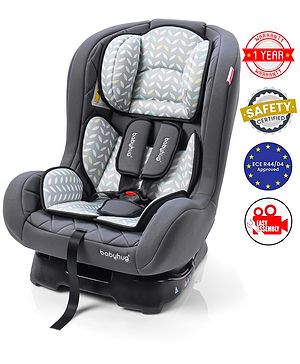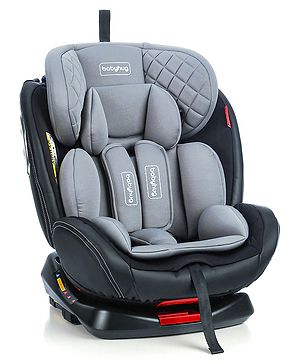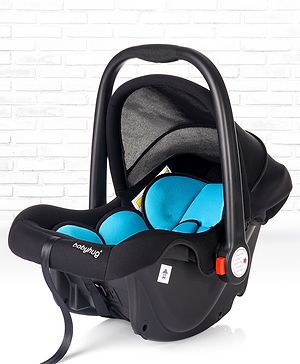Baby Car Seats
-
Babyhug Onyx Car Seat Cum Carry Cot With Rocking Base & Aluminium Handle - Pink - 67 x 42 x 55 cm Pink
Regular priceRs. 5,695.00Regular price Rs. 3,403.90Regular priceUnit price / perRs. 5,695.00Sale price Rs. 3,403.90 40% OFFSale -
Babyhug Expedition 3 in 1 Convertible Car Seat With Recliner with 1 Year Warranty - Grey| Side Impact Protection| Head Support| Adjustable Headrest| Safety Harness| Removable & Washable Seat Cover
Regular priceRs. 7,595.00Regular price Rs. 5,088.65Regular priceUnit price / perRs. 7,595.00Sale price Rs. 5,088.65 33% OFFSale -
Babyhug Expedition 3 in 1 Convertible Car Seat With Recliner 1 Year Warranty - Black Grey| Side Impact Protection| Head Support| Adjustable Headrest| Safety Harness| Removable & Washable Seat Cover
Regular priceRs. 7,595.00Regular price Rs. 5,088.65Regular priceUnit price / perRs. 7,595.00Sale price Rs. 5,088.65 33% OFFSale -
Babyhug Twins On Board Sign - Yellow
Regular priceRs. 149.00Regular price Rs. 104.30Regular priceUnit price / perRs. 149.00Sale price Rs. 104.30 30% OFFSale -
Babyhug Kids Convertible & 360 Degree Rotating Isofix Car Seat - Black Grey| Forward and Rear facing| Side Impact Protection| Reclining Seat| Head Impact Protection
Regular priceRs. 12,495.00Regular price Rs. 8,121.75Regular priceUnit price / perRs. 12,495.00Sale price Rs. 8,121.75 35% OFFSale -
Babyhug Onyx Elite Car Seat cum Carry Cot with Rocking Base and aluminium handle - Grey
Regular priceRs. 5,495.00Regular price Rs. 3,703.63Regular priceUnit price / perRs. 5,495.00Sale price Rs. 3,703.63 33% OFFSale -
Babyhug Amber Ace Car Seat Cum Carry Cot With Mosquito Net with 1 Year Warranty - Yellow| Rocker & Feeding Chair| Adjustable Handle Position| Safety Harness| Removable Canopy & Mosquito Net| Soft Padded Cushion| Removable & Washable Seat Cover
Regular priceRs. 5,295.00Regular price Rs. 2,488.65Regular priceUnit price / perRs. 5,295.00Sale price Rs. 2,488.65 53% OFFSale -
Babyhug Endeavor Isofix Convertible Car Seat - Black Grey
Regular priceRs. 12,495.00Regular price Rs. 6,497.40Regular priceUnit price / perRs. 12,495.00Sale price Rs. 6,497.40 48% OFFSale -
Babyhug Expedition 3 in 1 Convertible Car Seat With Recliner 1 Year Warranty - Black Grey| Side Impact Protection| Head Support| Adjustable Headrest| Safety Harness| Removable & Washable Seat Cover
Regular priceRs. 7,595.00Regular price Rs. 4,557.00Regular priceUnit price / perRs. 7,595.00Sale price Rs. 4,557.00 40% OFFSale -
Babyhug Amber Car Seat Cum Carry Cot With Rocking Base with 1 Year Warranty - Black Blue
Regular priceRs. 4,595.00Regular price Rs. 2,757.00Regular priceUnit price / perRs. 4,595.00Sale price Rs. 2,757.00 40% OFFSale -
Babyhug Safe Journey Forward Facing Car Seat - Grey
Regular priceRs. 6,995.00Regular price Rs. 4,197.00Regular priceUnit price / perRs. 6,995.00Sale price Rs. 4,197.00 40% OFFSale -
Babyhug Car Booster Seat (Color May Vary)
Regular priceRs. 1,495.00Regular price Rs. 971.75Regular priceUnit price / perRs. 1,495.00Sale price Rs. 971.75 35% OFFSale
Safe and Stylish: Baby Car Seats for Every Journey
Types of Baby Car Seats
- Infant Car Seats:
- Rear-Facing Only: Designed specifically for newborns and infants, these seats provide optimal safety by facing the rear of the vehicle, protecting the baby's head, neck, and spine in the event of a collision.
- Convertible Car Seats: These seats can transition from rear-facing to forward-facing, accommodating your child as they grow. They offer flexibility and extended use.
- All-in-One Car Seats: These seats offer multiple modes, allowing for rear-facing, forward-facing, and booster seat configurations, providing a long-term solution for your child's car seat needs.
- Travel System Car Seats: These come with a compatible stroller, allowing easy transfers from the car to the stroller without waking the baby.
- Convertible Car Seats:
- Rear-Facing to Forward-Facing: These seats can be used rear-facing for infants and then converted to forward-facing for toddlers, extending their usability.
- Extended Rear-Facing: Designed to keep children rear-facing for a longer period, enhancing safety.
- 3-in-1 Car Seats: These versatile seats can convert from rear-facing to forward-facing and then to a high-back booster, growing with your child.
- Booster Seats:
- High-Back Boosters: Provide support for the head and neck, which is ideal for vehicles without headrests.
- Backless Boosters: These are more compact and portable and are suitable for older children who need a height boost.
- Combination Seats: Transition from a forward-facing car seat with a harness to a booster seat.
Features
- Adjustable Harness: This harness provides a secure and adjustable fit for your child as they grow, ensuring safety and comfort.
- Recline Positions: Multiple recline positions help achieve the correct angle for rear-facing seats and provide comfort for forward-facing seats.
- Side-Impact Protection: Extra padding and energy-absorbing materials on the sides of the seat protect your child’s head and torso in a side collision.
- Removable and Washable Covers: These covers make cleaning up spills and messes easy and ensure hygiene and comfort.
- Built-In Lock-Offs: Assist with secure installation, preventing the seat from shifting in the event of a sudden stop or crash.
Weight Capacity
- Infant Car Seats: Typically support from 1.8 kg (4 lbs) to 15 kg (35 lbs). These seats are rear-facing only, providing the safest position for young infants.
- Convertible Car Seats: Range from 1.8 kg (4 lbs) in rear-facing mode up to 29.5 kg (65 lbs) in forward-facing mode, accommodating children as they grow.
- Booster Seats: Depending on the model, booster seats support children from 18 kg (40 lbs) up to 54 kg (120 lbs), providing a secure fit for older children who need a height boost.
Materials
- Polyester: Durable, easy to clean, and commonly used for car seat covers and padding. Polyester is practical and long-lasting.
- Mesh: Lightweight and breathable, mesh materials are used for ventilation and keeping the seat cool, especially in hot climates.
- Foam: High-density foam provides comfort and support, ensuring your child a safe and cushioned ride.
- Cotton: Soft, hypoallergenic, and gentle on sensitive skin, cotton is ideal for interior linings.
- Leatherette: Stylish, easy to clean, and durable, leatherette offers a luxurious feel and added protection against spills.
Buying Considerations
- Safety Standards:Ensure the car seat meets or exceeds safety standards. Look for features such as a 5-point harness, side-impact protection, and energy-absorbing foam.
- Compatibility: Verify that the car seat fits well in your vehicle and is compatible with your car's seat belt or LATCH system.
- Ease of Installation: Choose a car seat that is easy to install and adjust, minimizing the risk of incorrect installation.
- Adjustability: Look for seats with adjustable headrests, harnesses, and recline positions to accommodate your growing child.
- Portability: If you travel often, consider lightweight and portable options that are easy to carry and install in different vehicles.
Frequently Asked Questions (FAQs)
1. What is the best type of car seat for a newborn?
A. Infant car seats, specifically rear-facing only seats, are ideal for newborns as they provide the best safety and support.
2. How long should my child remain in a rear-facing car seat?
A. Children should remain in a rear-facing car seat until they reach the seat's maximum height or weight limit, typically around 2-4 years old.
3. Can a convertible car seat be used for newborns?
A. Yes, many convertible car seats are designed for use from birth and offer both rear-facing and forward-facing options.
4. How do I know if my car seat is installed correctly?
A. Follow the manufacturer's installation instructions and use the car's seat belt or LATCH system. It’s also recommended that a certified car seat technician check the installation.
5. What are the advantages of an all-in-one car seat?
A. All-in-one car seats grow with your child, transitioning from rear-facing to forward-facing and eventually to a booster seat, providing long-term use and value.
6. Are booster seats necessary for older children?
A. Yes, booster seats are necessary for older children who have outgrown their forward-facing car seats but are not yet tall enough for the car’s seat belt to fit properly.
7. How do I clean and maintain a baby car seat?
A. Most car seats have removable covers that are machine washable. It's important to regularly check the seat for wear and tear and follow the manufacturer’s maintenance instructions.
8. What features should I look for in a car seat for long road trips?
A. Look for extra padding, adjustable recline positions, cup holders, and good ventilation to ensure your child's comfort during long trips.
9. Can car seats fit in all vehicles?
A. It's important to ensure that your specific car model is compatible with the car seat, even though most car seats are designed to fit a wide range of vehicles.
10. Are car seats with higher weight limits safer?
A. Car seats with higher weight limits can be safer as they allow your child to stay in a harnessed seat longer, which is generally safer than using a seat belt alone.











